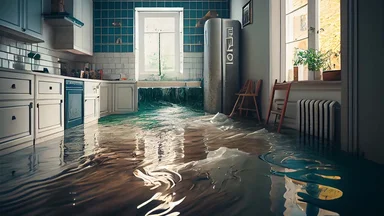Dry out water damage using building dehumidifiers

- Home
- Insights
- Humidity control and drying insights
- Dry out water damage using building dehumidifiers
In this article, we look at how you can prevent the costly process of tearing up your flooring after water damage by feeding hot, dry air continuously underneath it, therefore evaporating water from the insulation.
It is difficult to give exact guidelines for how to approach a water damage situation, as both the nature and extent of water damage varies considerably. However, there are some general points that you should always take into consideration.
First of all, it is essential to try and stabilise the affected area as quickly as possible to mitigate the risk of secondary damage to unaffected parts of the building. Initially, windows can be opened to allow excess humidity to escape, wet materials should be removed where possible, and standing water should be extracted where it is safe and practical to do so. If the property has any form of heating system available, it should be switched on to help aid the drying process until a professional contractor is available to survey the damage and install drying equipment. Taking these steps will help to mitigate the damage in the interim period before a contractor makes it to the property. If the water has had time to penetrate deep into the building structure you need to use extra dehumidification capacity to get quick results.
It is equally important to remove the moisture as quickly as possible. In most cases it is beneficial to add heat to the room to increase the evaporation. This is especially true if the water damage occurred recently and the water has not had time to penetrate deep into furniture, walls, floors and other parts of the building structure.
If the water has had time to penetrate deep into the building structure you need to use extra dehumidification capacity to get quick results.
Empirical values are essential to ascertain the required dehumidification load. Please read the rules of thumb.
Water damage under floors
Underfloor water damages often require you to tear up the flooring to replace the wet insulation. This is a time-consuming, troublesome and costly process because the damaged area becomes virtually useless for the duration of the repair work.
Often, a good commercial dehumidifier equipped to add heat to the process such as the AD 935S will spare you the time-consuming and costly inconvenience of having to break up all the flooring.
Hot dry air is fed underneath the floor at one end by means of ducts from the 1kW heater of the dehumidifier. To ensure sufficient air supply, the length of the ducts should not exceed 5 metres. The hot air continuously feeds through a hole at the other end, evaporating water from the insulation and taking up moisture as it passes under the floor. This allows you to use the room above the afflicted floor while the insulation is being dried out.
The theoretical calculation involved is extremely difficult. We advise you to use empirical values and read the rules of thumb.
Related products
Featured insights

How to calculate your dehumidification requirements

This article explains how you can calculate the dehumidification load for your specific settings

Discover everything you need to know about approaching a water damage restoration project.
Need help with choosing the right solution? Our team of over 100 climate control experts can assist.
You can also reach out or join the discussion on our Social Media. Check out our LinkedIn page.




